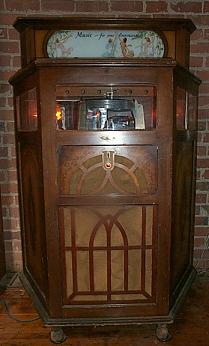About Us
Music of the era, such as ragtime, jazz, blues, and novelty songs, was nearly always written to be played on a piano. Sheet music provided the general tune, but it could only "come to life" by the skills of the artist playing the piano. This is why we are fortunate to have transcriptions of actual performing artists on the day - in the form of the piano roll.
The premier recording medium of the period, the perforated paper roll allowed notes and controls punched in the paper to operate the piano by working off vacuum from an electric pump. More importantly, it permitted a skilled arranger to encode the artist's expression in the music. Thus, the electric piano became a primary source of entertainment in an era before audio amplification was developed. The name Orchestria Palm Court derives from the term "orchestrion", a high-end version of the electric piano that also operates pipe, percussion, and even string instruments from the same punched paper roll. These were popular as substitutes for small orchestras, and reached their technological pinnacle in the 1920s.
Once amplified radio and jukeboxes became popular, the demand for orchestrions subsided; the stock market crash of 1929 effectively killed off further development. Yet music from these machines remains entertaining today as it was then. At the Palm Court, music comes from a variety of musical instruments; piano, pipes, bells, drums, and even a violin take part in making the songs come alive. We also play vintage vocal tracks from the era on our two period jukeboxes.
Imhof & Mukle "Commandant 2" Orchestrion
(ca 1920)
Providing entertainment at the Palm Court courtesy of the David William Allen and William Noble Lee Trusts, the Imhof & Mukle is a fine German instrument originally intended to emulate a small salon orchestra with its sophisticated violin pipe system.
Due to scarceness of music rolls of this type, the machine has been upgraded to a system that accommodates the "O" roll scheme used by Coinola, which greatly enhances the number of instruments that can be played.
The piano and violin pipes are now accompanied by a full complement of percussion instruments: bass drum, snare drum, wood block, triangle, and tambourine are all played automatically by the roll.


Deca Disc / Ristau Jukebox (1928)
Introduced in 1924, the Deca Disc phonograph is one of the earliest acoustic disc record jukeboxes to hit the market. As the name implies, it was originally intended to handle ten discs. However, engineering problems required a re-tooling that limited it to just five records.
The model in use at the Palm Court was a 1928 version produced when Ristau bought out Deca Disc. They converted the machine to electric amplification using a Silver-Marshall three-tube amplifier.
For more information, click here.
Wurlitzer Violin Piano (ca 1916)
This Wurlitzer electric piano uses pipes to emulate the sound of a violin that plays along with the piano keys when triggered by perforations in the roll. The effect is more like playing a piano and organ together, but is still interesting.
The type "APP" rolls available for this piano include many of the most popular hits of the day, with early jazz music arranged in an engaging and upbeat style. The Palm Court roll collection covers the period from 1913 to 1935.


Electramuse Jukebox (ca 1926)
The Electramuse jukebox uses a beefed-up redesign of the Deca Disc mechanism, allowing it to handle a full ten records. The Electramuse reproducer was optimized to play the then-new electrically recorded discs (as opposed to acoustically recorded discs). It contains no amplifier; its reproduction is purely acoustic.
For more information, click here.
Coinola "X" Orchestrion (ca 1920)
Operators Piano Company produced the Coinola line of electric pianos and orchestrions. Two of the machines seen and heard at the Palm Court use Coinola type "O" music rolls, which provide specific control channels for an incredibly diverse set of instruments. The Palm Court plays music dating from 1913 in this format.
The Coinola "X" model has many instruments to accompany the piano music, with both mandolin effects and two octaves of Deagan orchestra bells that can play a separate tune from the piano melody. Full percussion includes bass drum, snare drum, triangle, and wood block. For more information, click here.


Coinola "A" Electric Piano (ca 1910)
Coinola electric piano model "A", using type "A" rolls, is also on display at the Palm Court. The "A" rolls are of an earlier design used by Seeburg that have limited provisions for additional instrument control. However, the music available for them spans a wider range of years. The Palm Court plays music dating from 1906 in this format, and the collection includes original rolls dating to as late as the 1940s. For more information, click here.
Violano-Virtuoso Player Violin (ca 1925)
Mills Novelty Company manufactured what is considered one of the most amazing mechanical music machines ever, the Violano-Virtuoso. This advanced device plays a real violin together with piano accompaniment using clever electromagnetic techniques. Even the U.S. Patent Office touted the genius of the invention.
While versions of this machine were introduced to the market as early as 1907, the music rolls in the Palm Court collection were produced primarily between the years 1917 and 1933. For more information, click here.

info
@
orchestriapalmcourt.com